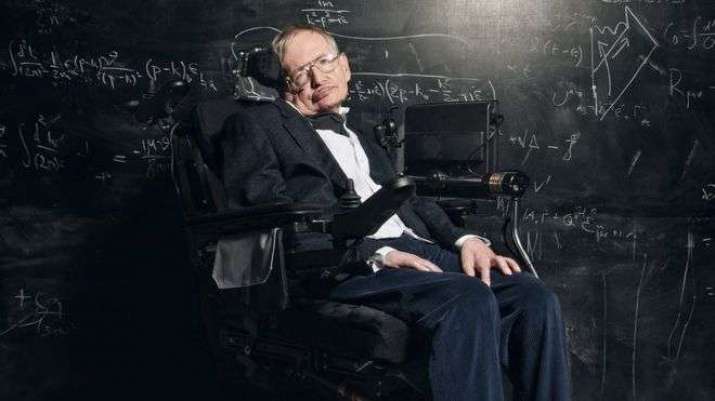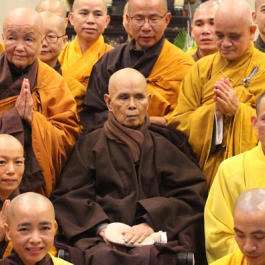
On 14 March, Stephen Hawking passed away at the age of 76. He was one of the most recognized, influential, and beloved cosmologists in the world. Diagnosed with motor neuron disease in his twenties, he lived far beyond the expectations of his doctors. He survived all the odds that had been pitted against him early in life and became a truly towering figure of science. He also found global popularity among the public, who loved him for his sharp sense of humor and his accessibility, as exemplified by his acclaimed books such as A Brief History of Time (1988).
His career was entwined with quantum physics and the most mysterious entities of the universe; black holes. In a 1974 paper titled “Black Hole Explosions?” he developed the theory of Hawking radiation. Rather than eternal and endlessly devouring matter and light, black holes not only have a temperature, but they radiate heat, and after billions and billions of years, once they have radiated all their heat, they disappear. His ground-breaking discoveries don’t end there. Just two weeks before his death, Hawking submitted a paper co-authored with Thomas Hertog, in which they proposed the mathematics that could lay the intellectual foundations for a “Star Trek-style space probe to find experimental evidence for the existence of a ‘multiverse’— the idea our cosmos is only one of many universes.” (news.com.au)
Hawking radiation itself is a theory that takes a small step towards reconciling Einstein’s theory of relativity with quantum mechanics, which have seeming contradictions. In 2015, based on serious questions raised by the Hawking radiation theory, Hawking had suggested that since no “information” or “matter” can be lost in quantum mechanics, what passes a black hole’s event horizon (what is absorbed by the black hole) can’t just disappear and must be converted one way or the other into something, whether it be the heat (energy) radiated by the black hole or—perhaps, just perhaps— something that is transmuted elsewhere in another universe.
His yet-to-be-published paper could potentially be his most important legacy, building on the idea that there could be “an infinite number of big bangs, each creating their own universe, a ‘multiverse’, which present[s] a mathematical paradox because it is seemingly impossible to measure.” (The Telegraph) Hints, or imprints, of a multiverse could possibly be found in the cosmic microwave background, the leftover heat from the Big Bang of our own universe.
Do other universes exist, and if so, how can we discover them? How did they come into being? Naturally, the multiverse idea has attracted cosmologists, astrophysicists, science fiction novelists, and the general public for decades. It would seem to be a more optimistic and positive outlook for us, because the current dominant theory is that we live in only one universe, and that it will likely end at least a googol year (10^100) into the future via heat death. Heat death, also described as thermodynamic equilibrium or maximum entropy, is the idea that galaxies keep expanding, moving further away from each other, due to the mysterious force of dark energy (which has evidence to support it), until, at one point, light from one galaxy can no longer reach the next. The stars burn out after exhausting their fuel, and even black holes degenerate and dissipate due to Hawking radiation. The idea that there are other universes even when this one dies is encouraging to many, both religious and non-religious.
The Buddhist scripture that aligns most closely with a vision of a potential multiverse is probably the Avatamsaka Sutra (Huayan jing in Chinese or Kegon kyo in Japanese). This sutra, purportedly transferred immediately after Sakyamuni Buddha’s enlightenment, presents a visionary multiverse reflected in the tiniest particle. Entire pantheons of Buddhas and bodhisattvas are present in a mote of dust, on a single blade of grass, or a grain of sand.
Certainly if one interprets our world of suffering in traditional Buddhist lore, the Saha World, to correlate with Earth, then the transcendent Buddha-fields perhaps aren’t “physically” somewhere else in another dimension, but are just waiting for us to discern them through insight prescribed by the Buddhist teachings. Certainly the idea that a switch in our paradigm can reveal a world totally foreign to our everyday perceptions has a somewhat “quantum” feel about it.
The relationship between science and religion remains controversial. If rebirth and karma need to remain cornerstones of Buddhist faith in any dialogue, we need to be careful about conflating two different forms of “knowing”—scientific knowledge and Buddhist insight. After all, the Buddha attained enlightenment in the distant past, and we now have an idea how much further this universe’s distant future will continue, thanks to the many cosmological discoveries that have come 2,500 years later. They might not be speaking the same language, but nor are they mutually exclusive.
Both science and religion have important things to say about empiricism, or the world as experienced through our perceptions and senses. Science is based on verification, of aligning theories with our empirical experience, and this reliance on empiricism has yielded immense benefits for humanity. However, Dharmic faiths based on insight (prajna) overcoming illusion (maya) have always noted that “our conception of the world” and “the world” are two very different things, and our limited perceptions only give us very limited view of what reality truly is.
Fortunately, Hawking, being the brilliant scientist that he was while not falling into dogmatic scientism, understood this. He remained non-religious throughout his life, believed in no afterlife, and saw this reality as the only one. The hunger for knowledge and understanding is not problematic as long as one is free from hubris and informed by humility about one’s smallness in the cosmos.
While it is the Triple Gem that pervades reality and gives Buddhists true meaning, it is true that Hawking possessed the kind of enquiring mind and hunger for understanding that would be commendable to everyone, not just scientists. Such an attitude would enrich everything we do, from the spiritual, to the artistic, and the scientific. It would transform our lives, just as Stephen Hawking has transformed how we understand the cosmos.
See more
Stephen Hawking’s final paper predicted the end of the world and revealed a parallel universe (news.com.au)
Stephen Hawking says he has a way to escape from a black hole (New Scientist)
Stephen Hawking’s ‘breathtaking’ final multiverse theory completed two weeks before he died (The Telegraph)
Huayan Buddhism and the Phenomenal Universe of the Flower Ornament Sutra (Ancient Dragon Zen Gate)
Why can’t Einstein and Quantum Mechanics get along? (Gizmodo)






